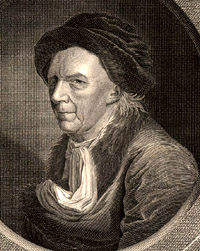Euler’s Letters to a German Princess: Translation and Betrayal
Suppose you had a goal of writing a short work that introduces the reader to the knowledge of almost everything—history and physics, astronomy and optics, logic and music, electricity and magnetism, theology and philosophy. How would you begin? What would be the final result? Perhaps, as with Bill Bryson’s 524-page A Short History of Nearly Everything [2003], you would discover that brevity is a relative concept.
Great mathematician Leonhard Euler (1707–1783) set himself precisely this project in what became Lettres à une Princesse d’Allemagne (Letters to a German Princess). Over the course of 234 letters written originally to Princess Charlotte Ludovica Luisa (a second cousin to Frederick II of Prussia), Euler laid out for the non-scientist the basics of a dozen disciplines. After the missives were published between 1768 and 1772 as a three-volume book, the work proved immensely popular. By the end of the eighteenth century it had been translated into almost every major European language and had gone through several dozen printings. In this article, we look at how asking questions about the first letter in the collection leads to questions about the chronology of the history of science, which in turn trigger questions about the translation process, which finally prompt questions about the motivations of those who edit subsequent editions of a publication. This is thus a story that can be used in the classroom to underscore the value of critical thinking with students bombarded outside the classroom by multimedia of various quality and promoting various agendas. We also hope, though, that instructors and students are inspired to dig further into the mathematical and scientific content of these remarkable volumes.
|
Figure 1. Leonhard Euler. |
Figure 2. Title page for volume 1 of Euler‘s |
This essay is adapted and updated from two columns [Klyve 2011a; Klyve 2011b] that originally appeared in the newsletter of the Euler Society.
Euler's Letters to a German Princess: Translation and Betrayal – The First Letter
In order to gain insight into Euler’s approach to this informal pedagogical relationship with a fifteen-year-old female student from the nobility, we will explore the first letter: “l’Entendue” (“Magnitude” or “Size”). In the first sentence, Euler promised to produce “examples of the smallest as well as the greatest extensions of matter actually discoverable in the system of the universe” [Euler 1795, p. 1]. After describing some distances relevant to daily life in the eighteenth century, Euler expanded his view to include Earth itself:
We shall have a tolerably just idea of the magnitude of the earth, when we are told that its circumference is about 5,400 miles. And the diametre being a straight line passing through the centre, and terminating, in opposite directions, in the surface of the sphere, which is the acknowledged figure of the earth, for which reason also we give it the name of globe, the diameter of this globe is calculated to be 1720 miles [Euler 1795, p. 3, emphasis in source].
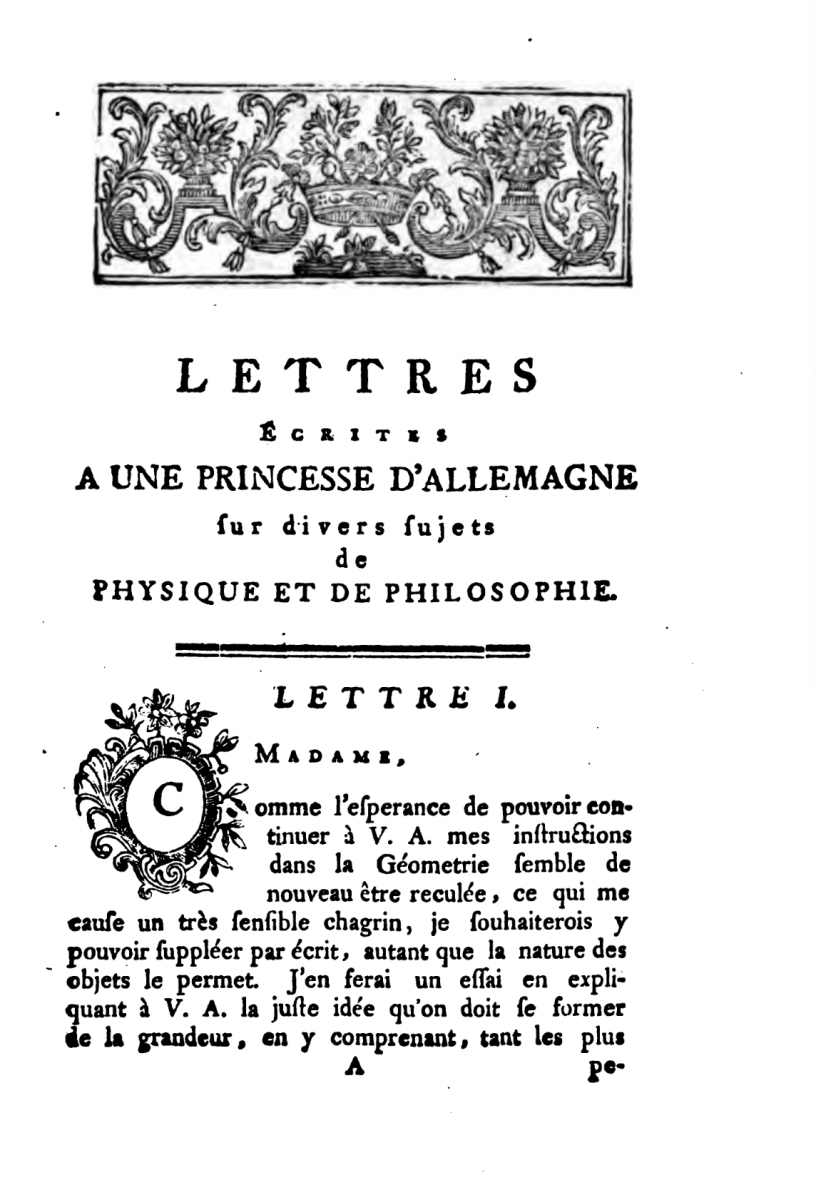
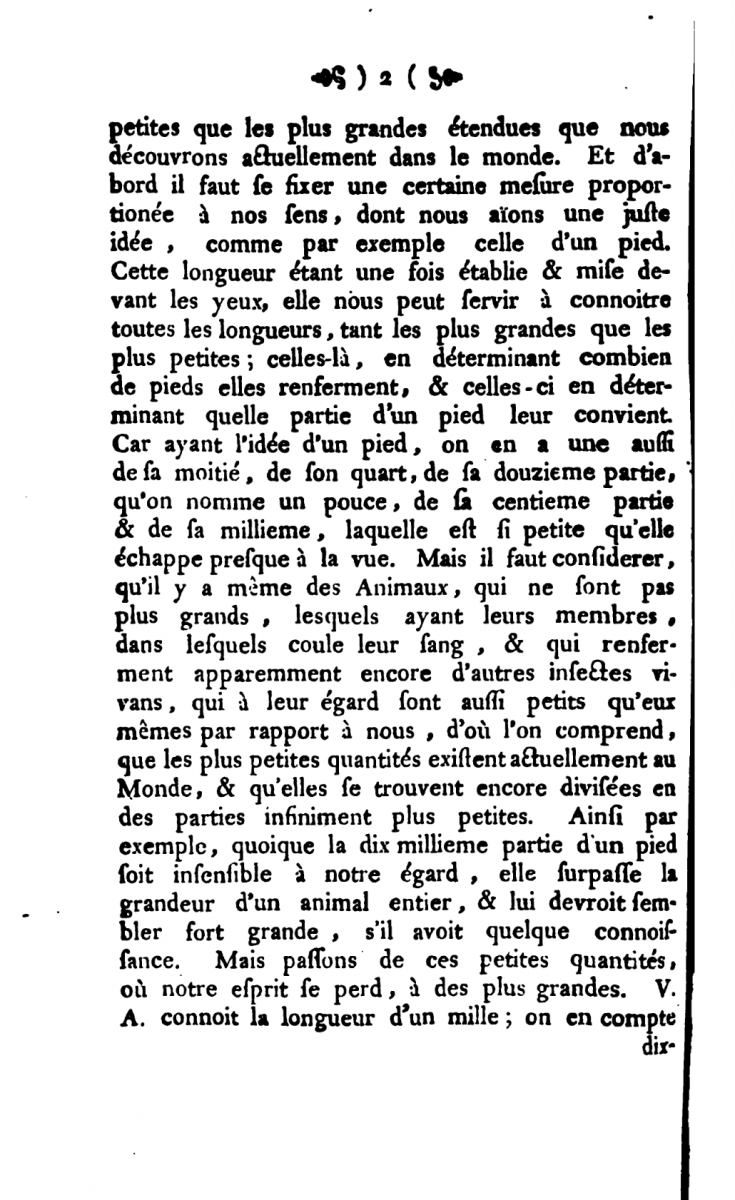
Figure 3. First two pages of Euler’s first letter to Princess Friederike Charlotte. Euler Archive.
Two things in this passage are worthy of our notice. First, Euler had chosen to measure distances in German miles, which are about 4.7 times as long as their English cousins. Thus, the circumference reported in this letter is approximately 25,380 miles (40,845 km), an overestimate of about 2%. Second, the Earth is not shaped like a sphere, and Euler knew this well. Two teams of scholars, organized by Pierre Louis Moureau de Maupertuis, had undertaken long voyages to Lapland and South America in the 1730s in order to measure a degree of longitude. Euler was among those who used their measurements to calculate that the Earth was wider at the equator than at the poles, confirming a prediction of Newtonian physics [Euler 1738]. Euler resisted the temptation to tell this story here, sticking instead to a gentle fiction that furthered his goals in the letter. Once he established the diameter of the Earth as a unit that could be used to make other distances easier to understand, Euler proceeded to discuss the distance to the moon and the sun:
Of all the heavenly bodies the moon is nearest us, being distant only about 30 diameters of the earth, which amount to 51,600 miles, or 1,238,400,000 feet; but the first computation, of 30 diameters of the earth, is the clearest idea. The Sun is about 300 times farther from us than the moon; and when we say [its] distance is 9,000 diameters of the earth, we have a much clearer idea, than if it were expressed in miles, or feet [Euler 1795, p. 4].
Euler moved next to the rest of the solar system, giving the distance to the sun and naming the planets. This section is particularly interesting in the most widely-distributed printing of Henry Hunter’s 1795 English translation, in which Euler is presented as having written:
Besides the Earth, there are ten other similar bodies, named planets, which revolve round the sun; two of them at smaller distances, Mercury and Venus; and eight at greater distances, namely, Mars, Ceres, Pallas, Juno, Vesta, Jupiter, Saturn, and the Georgium Sidus [Euler 1823, p. 31, emphasis in source].
I have seen this list mentioned in many places. The careful reader should wonder, however, just how Euler predicted some of these "planets"—particularly Ceres (1801), Pallas (1802), Juno (1804), Vesta (1807), and the so-called Georgium Sidus (1781)—since none but the largest would be discovered until many years after Euler's death in 1783. The short answer, of course, is that he didn’t! The long answer is more interesting. Explaining what Ceres etc. are doing in this translation requires understanding how and why the Letters to a German Princess were translated in the first place.
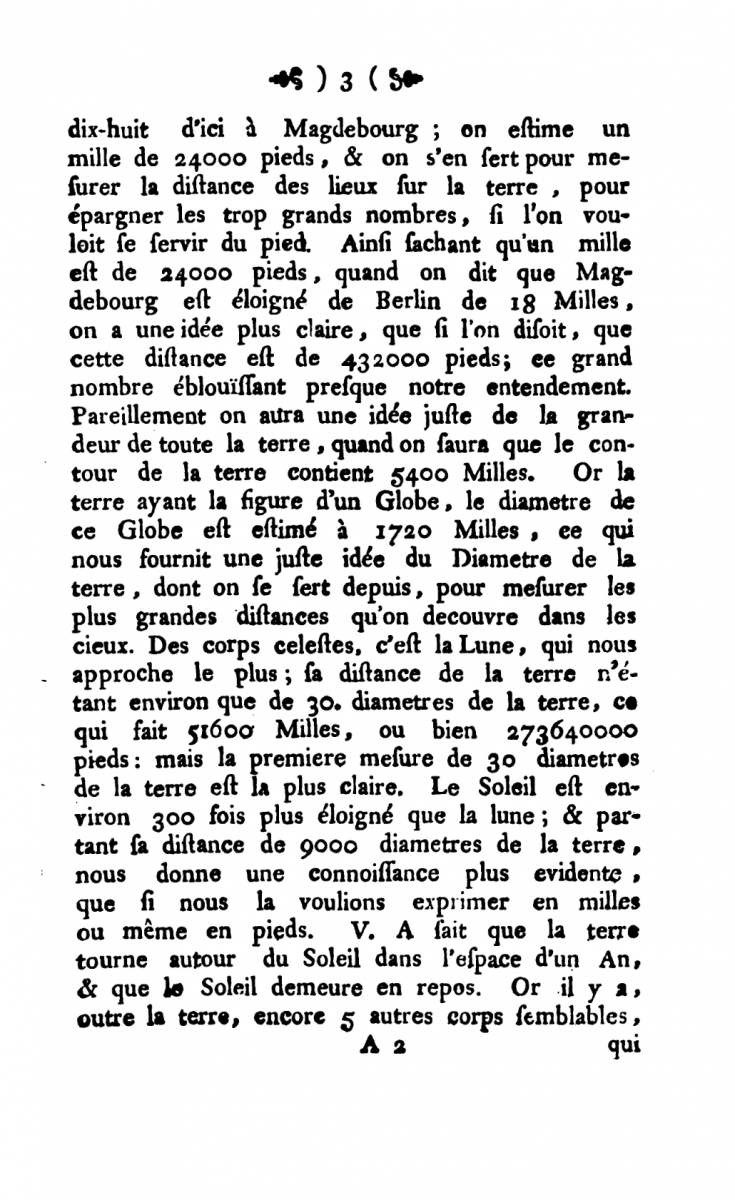
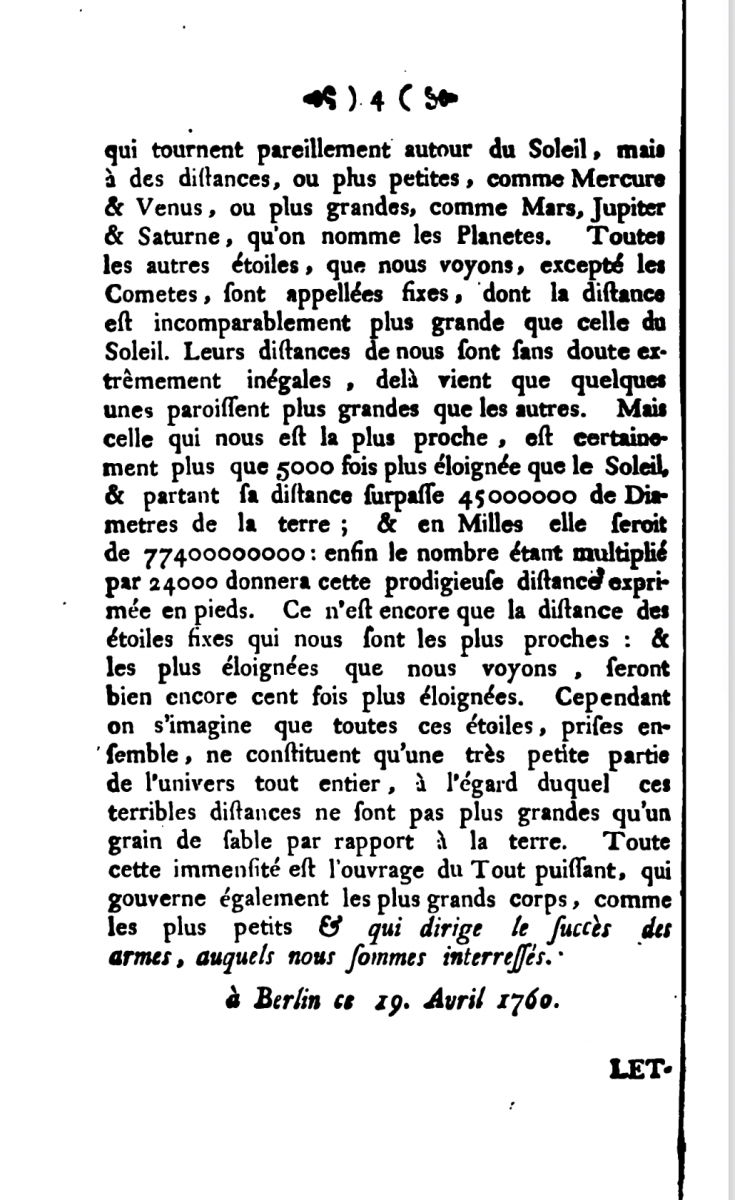
Figure 4. Last two pages of Euler’s first letter to Princess Friederike Charlotte. Euler Archive.
Euler's Letters to a German Princess: Translation and Betrayal – Euler's Lettres in English
Until this point, we have been reading Euler via an English translation by Henry Hunter (1741–1802). Hunter, a Scottish minister who had just completed a translation of the Essays on Physiognomy by Johann Kaspar Lavater (1741–1801), in 1795 took upon himself the considerable task of translating the Lettres. Believing that Euler’s main goal was to educate women and girls, Hunter targeted his work at British women. Of course, differences in grammar, vocabulary, and historical viewpoint can be challenges for any translator seeking to faithfully render the author’s ideas in another language. Most of the possible problems occur despite the translator’s best intentions; however, a much more insidious form of betrayal occurs when the translator replaces an author’s words with new words or undermines the author’s intent. In its worst form, this alteration of the original text is hidden, and a reader without access to the original will be forever ignorant of the author’s true aims.
Hunter thus provided a raison d'être for his translation of the Lettres. After a long discussion in his introduction of the remarkable progress that women’s education had made in recent decades, Hunter expressed his hope for the translation in its first English edition:
The time, I trust, is at hand, when the Letters of Euler, or some such book, will be daily on the breakfasting table, in the parlour of every female academy in the kingdom; and when a young woman, while learning the useful arts of pastry and plain-work, may likewise be acquainting herself with the phases of the moon, and the flux and reflux of the tides. And I am persuaded she may thrum on the guitar, or touch the keys of the harpsicord, much more agreeably both to herself and others, by studying a little the theory of sound. I have put the means of this in her power; it will be at once her fault, and her folly, if she neglect it [Euler 1795, p. xiii].
Hunter, at first glance, seems to be transparent about his intentions (however paternalistic they may seem). Crucially, he tells the reader precisely which version of Euler’s Lettres he translated:
In translating the Work, I have followed the last Paris Edition, given by Mssrs. De Condorcet and de la Croix, in 1787, for the purpose of introducing the useful notes of these gentlemen; but I have taken the liberty to restore, from the original edition, that of Mietau and Leipsic, in 1770, several passages which the French Editor had thought proper to suppress [Euler 1795, pp. xiii–xiv, emphasis in source].
Note the curious reference to “suppressed” passages of Euler—we will return to these later. For now, however, we consider Hunter’s work itself. Soon after demonstrating his careful attention to detail, however, he tells us that he has not, in fact, translated everything. In a passage containing a somewhat surprising theological digression, Hunter writes:
The frequent, tiresome, courtly address of, Your Highness, except at the first setting out, I have entirely omitted; out of no disrespect to Princes, but because it seemed, to me, a mere unnecessary waste of words, which only encumber, and disfigure, a work of science. The Princess and her Instructor are both gone to that awful world, in which the distinctions of the present, those of virtue excepted, are for ever obliterated [Euler 1795, p. xvii].
Excising any words from a translation is viewed more suspiciously today, but this is not perhaps a terrible omission. At least he thought it worth mentioning the excision to his readers. However, something more problematic occurs when sections are not only excised, but altered without the reader's knowledge. Recall that Euler’s list of planets included three asteroids (Pallas, Juno, and Vesta), one dwarf planet (Ceres) and the planet "Georgium Sidus," all presumably unknown to Euler. Hunter, on the other hand, could have known of Ceres, Pallas, and “Georgium Sidus.” Thus, a reasonable interpretation is that Hunter updated scientific information as he translated, with more updates made by later editors and printers as more discoveries were made—all of them reasoning, perhaps, that the goal of Euler’s work was to teach the latest science. While such interventions are not a preferable editorial practice by current standards, Hunter might be forgiven in such a circumstance, though surely the translator needs to inform their readers of their changes! (For the record, "Georgium Sidus" is Latin for “George’s Star”, a name chosen by its discoverer William Herschel in a largely successful attempt to ingratiate himself to King George III; today we know it as Uranus.)
Euler's Letters to a German Princess: Translation and Betrayal – Lists of Planets in Other Translations
I began to wonder how common the added heavenly bodies were among translators. According to Gustaf Eneström’s definitive early-twentieth-century list of Euler’s publications [Eneström 1910], there have been at least 34 editions published in 9 languages (French, Russian, German, Dutch, Swedish, Italian, Danish, and English, in chronological order of first translation). Via Interlibrary Loan and the magic of the internet, I have been able to track down 20 of these to make a comparison (see table below). After examining these, the sheer weight of evidence led me to change my mind about Hunter’s choices. Not only should Hunter be forgiven for cutting corners with his translation, he should be exonerated entirely. It turns out that Hunter’s original text (Euler 1795, E343G in Gustaf Eneström’s catalog of Euler's works) lists precisely those planets listed by Euler! (Particularly close readers who noticed Hunter’s death date of 1802 may not be as surprised to hear this.) However, the reprinting on my shelf (E343G4)—which happens to be the most widely distributed English version—does include the extra planets. So what happened? Hunter made some changes to a second edition (E343G2) that appeared in the year of his death, such as adding a glossary, but he left the list of planets at five (Mercury, Venus, Mars, Jupiter, Saturn). A third edition (E343G3) was edited by David Brewster (1781–1868) in Edinburgh in 1823; American John Griscom (1774–1852) added more footnotes and published a fourth edition (E343G4, the version I own) in New York in 1833. Since copies of Brewster’s 1823 version are relatively rare and none have been digitized, I have not been able to determine whether Brewster or Griscom were responsible for the extra planets.

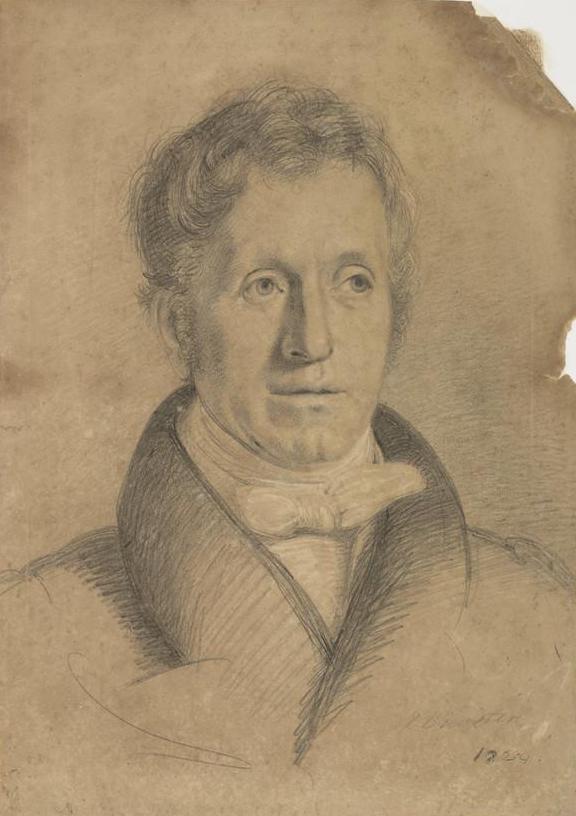
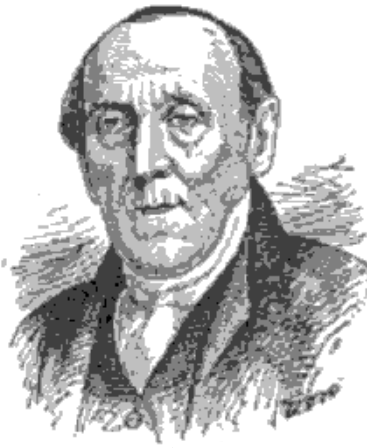
Figure 5. Henry Hunter (left) did not add the extra planets; was the culprit David Brewster (center)
or John Griscom (right)? Wikimedia Commons (Hunter/Griscom) and National Galleries Scotland,
Creative Commons - CC by NC (Brewster).
Indeed, the decision about what to do with the list of planets seems to have been a vexing one for many translators and editors of the Lettres. The basic question: Given that Euler’s purpose was to give a list of all the planets, and that we now know about more than he did, should we put them in? Different translators have given different answers to this question over time. For instance, in 1798 a Spanish translator added a footnote describing the newly discovered planet "Herschell" (yet another early name for Uranus). In the 1847 German translation (E343B5), Uranus is inserted directly into the text, as if Euler had written it. A footnote alerts the reader to the fact that Uranus had not yet been discovered when Euler wrote, before proceeding to mention Vesta, Juno, Ceres, and Pallas (naming them as planets, also), and then to describe in considerable detail and with no small amount of patriotic pride the orbital dynamics of a fifth planet, "Astraea," located between Mars and Jupiter, which had just been discovered by the German astronomer Karl Ludwig Hencke (1793–1866). The French editions of 1812 and 1829 (E3435 and E3436) put Uranus and the four minor planets in a footnote, but the edition from the Belgian Oeuvres Completes (E3437), published ten years later, omits them completely. Things are, in short, a mess.
Nor is the list of planets the only thing to vary between editions and translations. Again looking only at Euler’s first letter, I found four different items that translators and editors seemed to feel free to change at will. In order of appearance in the letter:
- The direct address to the princess. This is simple and elegant, even in Euler’s original (he writes simply "Madame"). Some editions, however, find this unnecessary, and cut it altogether.
- The units of distance. Euler gave the distance from Berlin to Magdeburg as 18 miles. His units, however, are German miles—each roughly 4.5 English miles. This question to me is more interesting: When translating the language, should the translator also translate units into those more familiar to the reader?
- The list of planets. This is the issue described in detail above.
- The final sentence. The last sentence of Euler’s first letter is surprising. Once he finished his discussion of the size and immensity of the cosmos, he wrote "This immensity is the work of the Almighty, who governs the greatest bodies and the smallest, and who is now crowning with success the arms in which we are so deeply interested" [Euler 1795, p. 5. The latter part of the translation (in italics) was moved by Hunter to a footnote.]
This last clause, written during a successful period for Prussia in the Seven Years’ War, appears in italics in the Opera Omnia’s printing of the original text. It was ignored by most translators, and derided by others (in E343G and E343G2, Hunter pointed out that “philosophers, as well as other men, are under the dominion of local and temporary circumstances”). While I am still missing several editions of the Lettres known to Eneström, I managed to obtain the first letter in sixteen editions, and compiled a table showing how each handles the four issues above.
Table 1. A catalogue of the many variations of Euler's first letter from Lettres à une princesse d'Allemagne sur divers sujets de physique & de philosophie [E343]. Starred (*) entries indicate that a footnote explained the final clause of Euler's letter to be a reference to the Seven Years’ War.
| Edition | Year | Language | Address | Planet List | Berlin to Magdeburg Distance | Last clause |
| E343 | 1768 | French | Madame | Stops at Saturn | 18 miles | Present |
| E3432 | 1770 | French | Madame | Stops at Saturn | 18 miles | Present |
| E3434 | 1787 | French | Madame | Stops at Saturn | 18 miles | Missing |
| E3435 | 1812 | French | Madame | Footnote mentions Uranus, Vesta, Juno, Ceres, Pallas | 18 miles | Present |
| E3436 | 1829 | French | Madame | Footnote mentions Uranus, Vesta, Juno, Ceres, Pallas | 18 miles | Missing |
| E3437 | 1839 | French | Madame | Stops at Saturn | 18 miles | Missing |
| E3438 | 1842 | French | Madame | Footnote mentions Uranus, Vesta, Juno, Ceres, Pallas | 18 miles | Present |
| E3439 | 1843 | French | Madame | Footnote mentions Uranus, Vesta, Juno, Ceres, Pallas | 18 miles | Present* |
| E34312 | 1866 | French | Madame | Footnote mentions Uranus, Vesta, Juno, Ceres, Pallas | 18 miles | Present* |
| E343A | 1769 | Russian | none | Stops at Saturn | 18 miles | Present |
| E343B | 1769 | German | none | Stops at Saturn | 18 miles | Missing |
| E343B2 | 1773 | German | none | Stops at Saturn | 18 miles | Missing |
| E343B5 | 1847 | German | none | Footnote mentions Uranus, Vesta, Juno, Ceres, Pallas, and one other (Astrea), with many details about it | 18 miles | Missing |
| E343B6 | 1853/4 | German | none | List includes Uranus; footnote mentions Ceres, Pallas, Juno, Vesta; many details about discovery and orbit of "planet" Astrea are given | 18 miles | Missing |
| E343C | 1785 | Dutch | Mevrouwe | Stops at Saturn | 18 miles | Missing |
| E343E | 1787 | Italian | none | Stops at Saturn | 18 miles | Missing |
| E343G2 | 1802 | English | Madam | Stops at Saturn | 18 miles | In a footnote |
| E343G4 | 1833/4 | English | none | List includes "Ceres, Pallas, Juno, Vesta… and the Georgium Sidus" | 83 miles | Missing |
| E343G9 | 1858 | English | none | List includes "Ceres, Pallas, Juno, Vesta … and the Georgium Sidus" | 83 English miles | Missing |
| E343H | 1798 | Spanish | Señora | Footnote mentions "Herschell," and that it is also called Uranus | 18 miles (footnote also gives distance in Castilian feet) | Missing |
Euler's Letters to a German Princess: Translation and Betrayal – Condorcet's Distortions
As we can see, the story behind the translation of the Lettres is complex, and it has not been fully told. Before pursuing this story further, however, I became distracted by an issue even deeper than that of translation. I learned that there are several examples of textual betrayal in the French editions—in the most widely distributed edition of the Lettres, Euler’s words were systematically abridged for political purposes.
The most widely-distributed and well-known edition of the Lettres (and the one from which Henry Hunter made the only English translation to date) is probably the third (E3434, published in 1787), an edition in which the Marquis de Condorcet played a significant role. Condorcet and Euler at first seem like a wonderful match—a leading scientist and philosopher helping to edit the works of a giant of the previous generation. However, Condorcet’s efforts were not as selfless and honorable as we might expect: he systematically and deliberately edited Euler’s work by excising passages that he didn’t think belonged.
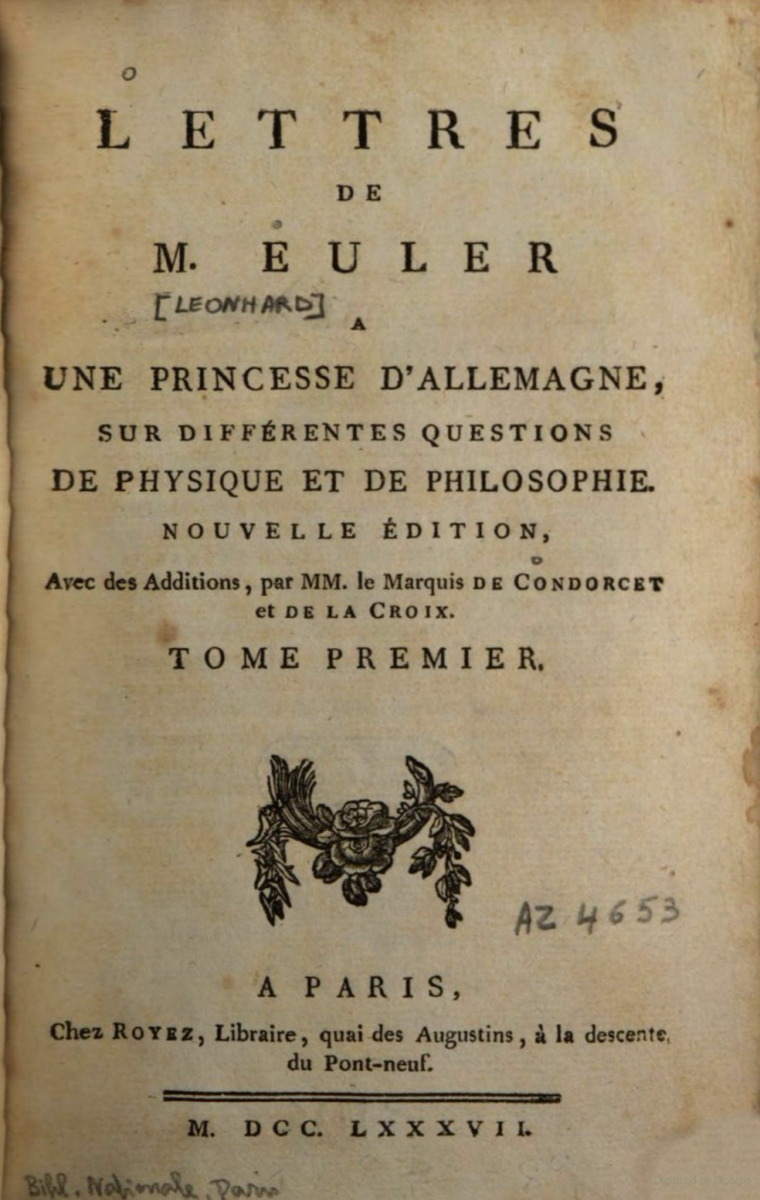
Figure 6. Title page from the 1787 edition of Lettres edited by Condorcet and others. Google Books.
Condorcet’s name is perhaps not as well known in the mathematical or scientific communities as it is to historians. He was a competent but not a great mathematician. His greatest achievements were perhaps quasi-mathematical: he was one of the first people to apply mathematics to understand human behavior. (We still see his name while studying voting theory, for example, as described in the Convergence article, “The French Connection: Borda, Condorcet and the Mathematics of Voting Theory.”) He was an influential figure in the French Revolution and was, in the words of E. O. Wilson, “a complete revolutionary, both anticlerical and republican” [Wilson 1998]. He was committed to the idea of human progress and to creating a “more perfect social order ruled by science and secular philosophy” [Wilson 1998, p. 19].
Condorcet’s legacy in Euler’s Lettres came to my attention via an unexpected source. In 1747, Euler published an anonymous tract titled Rettung der Göttlichen Offenbahrung gegen die Einwürfe der Freygeister (E92, Defense of divine revelation against the objections of the freethinkers). Some years ago, Andie Ho translated this work into English [Défense 1805], but in fact, she did much more than this. She also translated a book containing the Rettung as one part [Défense 1805], originally published by Adrien Le Clere (an official printer of the Vatican, based in Paris) in 1805. The Le Clere book includes a brief discussion about how difficult it had been for the publishing house to locate a copy of the Rettung, and then reprints the entire work (in a French translation of Euler’s original German). The anonymous editor of the book follows Euler’s tract with an essay that startled me, and which provided the final piece for my investigations. The essay, “Comparison of the last edition of Euler’s Letters published by de Condorcet, with the original edition,” carefully demonstrates that Condorcet removed, wherever possible, Euler’s references to God, salvation, and scripture.
That Euler was a devout man is well known; he often used theological arguments to buttress or explain his scientific ones, and he found no conflict in this. Condorcet, however, found these ideas anathema to the ideals of the Enlightenment in general and to the goal of teaching science through the Lettres in particular. He thus removed Euler’s theological references in every letter in which doing so wouldn’t destroy the purpose of the letter. Hunter found and restored some of Condorcet’s excisions, but not all of them. The first letter in which this occurs seems to be Letter 18. By the end of this letter, Euler believed that he had shown that Newton had erred in his theory of light emission from the sun, and concluded with a lengthy philosophical reflection:
If we are prone to such sad mistakes in our research on the phenomena in this visible world, a world which we can sense, how unfortunate would we be if God had abandoned us to ourselves with regards to the invisible world and our eternal salvation. On this important point, a revelation is absolutely necessary to us. We should make the most of it with the greatest veneration; and when this revelation presents us with things that seem inconceivable, we have but to remember the weaknesses of our mind, which strays so easily, even for the visible things. Each time I hear these freethinkers criticize the truths of our religion and even mock it with the most impertinent self-importance, I think and say to myself, “Puny mortals, no matter how lightly you gloss over these things and how many you ignore, they are more sublime and elevated than those on which the great Newton was so grossly mistaken. I hope that Your Highness never forgets this thought; the times when you are in need of it come all too often” [Défense 1805].
This entire passage was cut by Condorcet. In his translation, Henry Hunter, a Scottish minister with no desire to hide Euler’s piety, restored the passage in a footnote at the end of the letter [Euler 1795, p. 82–83]. Hunter, however, didn’t find every passage that Condorcet removed. The first example I can find that Hunter missed occurs in Letter 21. In an attempt to give some meaning to the vast distance to the stars, and the finite speed of light, Euler in his original letter invokes a Biblical reference:
If, at the beginning of the world, the stars had been created at about the same time as Adam, he would not have been able to see even the closest ones for six years; he would have had to wait even longer before discovering the others, since they are even farther from the Earth [Défense 1805].
Condorcet cut this sentence from Euler’s letter, presumably in the belief that reference to figures such as Adam did not befit a scientific work. As noted above, this sentence does not appear in the first English edition [Euler 1795, p. 97]. Nor, according to keyword searches of digitized copies of E343G, E343G2, and E343G4, is there any mention of Adam in any of the English printings of the Letters except for a brief reference to Adam and Eve at the beginning of Letter 116 (the first letter in volume 2 of each edition) [Euler 1795, vol. 2, p. 1; Euler 1802, vol. 2, p. 1; Euler 1833, vol. 2, p. 1].
The book published by Le Clere goes on to list dozens of instances in which Condorcet and the other French editors removed passages from Euler’s work. They range from the trivial to the significant, yet their sum total means that the reader who only sees Euler in a later French edition, or in English translation, will end up with a distorted sense of Euler’s thought.
Condorcet was unapologetic about rewriting Euler’s work. It is interesting and instructive to read his Avertissement at the beginning of the book. (Convergence’s Mathematical Treasures entry for Lettres provides images of this edition’s entire Avertissement.) “Without failing in the respect due to Euler,” Condorcet wrote, “I thought myself at liberty to omit some passages altogether, and to correct the style of others.” He then spent more than a page justifying this, claiming that although it may be unreasonable to expect a non-native speaker to write “a foreign language with classical purity,” some readers who didn’’t already know Euler’s greatness might judge him harshly for this. Wanting to save Euler from such judgment, Condorcet apparently edited his French for style. Having devoted considerable attention to this, he then almost glossed over the changes we discussed above:
As to other retrenchments, they affect, almost all of them, reflections which relate less to the science and philosophy, than to theology, and frequently even to the peculiar doctrines of that ecclesiastical communion in which Euler lived. It is unnecessary to assign a reason for omissions of this description [Condorcet 1787, pp. iii–vi, my translation].
Euler's Letters to a German Princess: Translation and Betrayal – Conclusion
At the end of this, my exploration of Euler’s Lettres, what have we found?
Certainly, I am pleased that, 250 years after they were written, the letters remain rich in scientific, philosophical, and didactic content. Readers looking for assistance with the technical details can consult scholarly assessments such as the older article and more recent book from Ron Calinger (the latter written with Katya Denisova and Elena Polyakhova) [Calinger 1976; Calinger 2019]. However, when attempting to consult the primary source, we seem to find ourselves in an uncomfortable position: this brilliant work, one of Euler’s most popular books, exists in English only in bowdlerized form. Perhaps even more alarmingly, we discovered that going back to the French original is helpful only if we use the very first printing—too many changes have snuck in (and back out again) during later printings.
Fortunately, in our modern information age, the original is readily available online [Euler 1768–1772]; moreover, the Opera Omnia has reprinted and re-typeset the original faithfully. To anyone interested in reading or using the Letters to a German Princess, I cannot recommend too strongly the importance of checking assertions and quotations against these renderings of the original French text. It’s now clear to me how very vital it is to have a new translation of the Lettres—one written in modern English, and one faithful to Euler’s work. Until this work is finished, Euler’s legacy to the English-speaking world will not be complete.
Euler's Letters to a German Princess: Translation and Betrayal – References
Bryson, Bill. A Short History of Nearly Everything. Broadway Books, 2003. Illustrated, expanded edition issued by Penguin Random House, 2010.
Calinger, Ronald. "Euler's 'letters to a princess of Germany' as an expression of his mature scientific outlook." Archive for History of Exact Sciences. Vol. 15, No. 3 (1976), pp. 211–233.
Calinger, Ronald, Ekaterina Denisova, and Elena N. Polyakhova. Leonhard Euler’s Letters to a German Princess: A Milestone in the History of Physics Textbooks and More. IOP Publishing, 2019.
Condorcet, marquis de, and Sylvestre-François Lacroix, eds. Lettres de M. Euler a une princesse d'Allemagne, sur differentes questions de physique et de philosophie. Paris, 1787. Eneström number E3434.
Défense de le Révélation contre les objections des esprits-forts, by M. Euler, suivie des penseées de cet auteur sur la religion, suprimeées dans la dernière edition de les letters a une princesse d’Allemagne. Chez Adrien Le Clere, Imprimeur de N.S.P. le Pape, 1805. Original scan and English translation by Andie Ho; available on the Euler Archive. Eneström number 92B.
Eneström, Gustaf, ed. Verzeichnis der Schriften Leonhard Eulers. Jahresbericht de Deutschen Mathematiker-Vereinigung. Supplementary Vol. 4. Leipzig, 1910.
Euler, Leonhard. “Von der Gestalt der Erden.” In Anmerckungen über die Zeitungen. St. Petersburg, 1738. Eneström number E32.
Euler, Leonhard. Rettung der Göttlichen Offenbahrung gegen die Einwürfe der Freygeister. Berlin, 1747. Eneström number E92.
Euler, Leonhard. Lettres à une princesse d'Allemagne sur divers sujets de physique & de philosophie. 3 vol. St. Petersburg, 1768–1772. Eneström number E343.
Euler, Leonhard. Letters of Euler on Different Subjects in Physics and Philosophy, Addressed to a German Princess. Translated by Henry Hunter. 2 vol. London, 1795. Eneström number E343G. 2nd edition published in 1802. Eneström number E343G2.
Euler, Leonhard. Letters of Euler on Different Subjects in Physics and Philosophy, Addressed to a German Princess. With Notes, and a Life of Euler, by David Brewster. Translated by Henry Hunter. 2 vol. Edinburgh, 1823. Eneström number E343G3. Reprint; New York: J. & J. Harper, 1833. Eneström number E343G4.
Klyve, Dominic. “The Omnipresent Savant: Euler as Master Teacher in Letters to a German Princess.” Opusculum. Vol. 2, No. 2 (Autumn 2010), pp. 17–21.
Klyve, Dominic. “The Omnipresent Savant: Euler’s Letters to a German Princess: Betrayal and Translation.” Opusculum. Vol. 3, No. 1 (Spring 2011), pp. 23–26.
Klyve, Dominic. “The Omnipresent Savant: Seeking the Original Text of Euler’s Letters to a German Princess.” Opusculum. Vol. 3, No. 2 (Summer 2011), pp. 30–32, 34.
Wilson, E. O. Consilience: The Unity of Knowledge. Alfred A. Knopf Press, 1998.
Euler's Letters to a German Princess: Translation and Betrayal – Acknowledgments and About the Author
Acknowledgments
The author would like to thank the Euler Society and its members for their encouragement in this work, and for many helpful conversations over the years at conferences and meetings. The author would also like to acknowledge that earlier versions of this work appeared as parts 2 and 3 of a three-part sequence of columns in Opusculum (Volume 3, issues 1 and 2), the newsletter of that society. The original versions of these newsletters can be accessed at http://faculty.washington.edu/etou/eulersoc/press.htm.
About the Author
Dominic Klyve is Professor of Mathematics at Central Washington University. He is the author of more than 50 papers in number theory, the history of mathematics and science, and applied statistics. His interdisciplinary works have appeared in journals ranging from Gastrointestinal Endoscopy to Shakespeare Quarterly. Klyve has been nationally recognized for promoting the use of primary sources in the teaching of mathematics, and currently serves as a PI on the National Science Foundation TRansforming Instruction in Undergraduate Mathematics via Primary Historical Sources (TRIUMPHS) grant to develop and study classroom materials for this purpose. He was a 2014 winner of the MAA’s Henry L. Alder Award for Distinguished Teaching by a Beginning College or University Mathematics Faculty Member, and currently serves as editor of the College Mathematics Journal.
